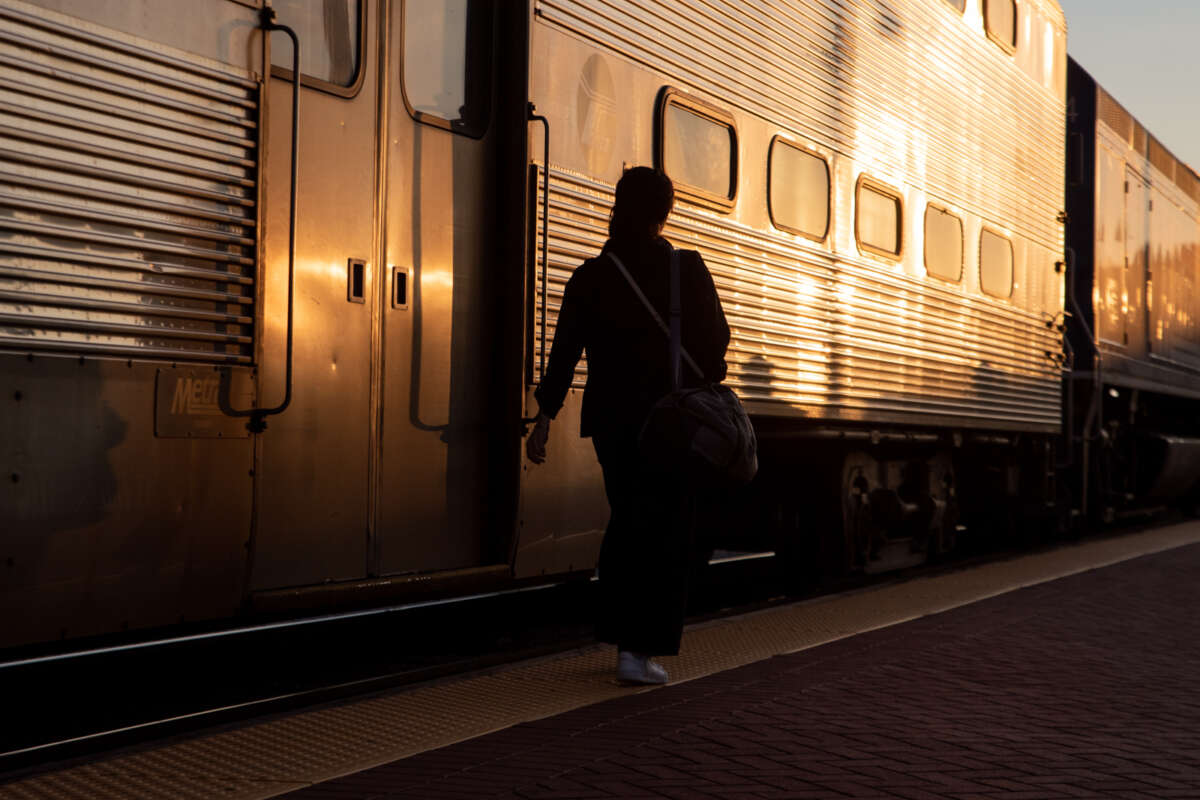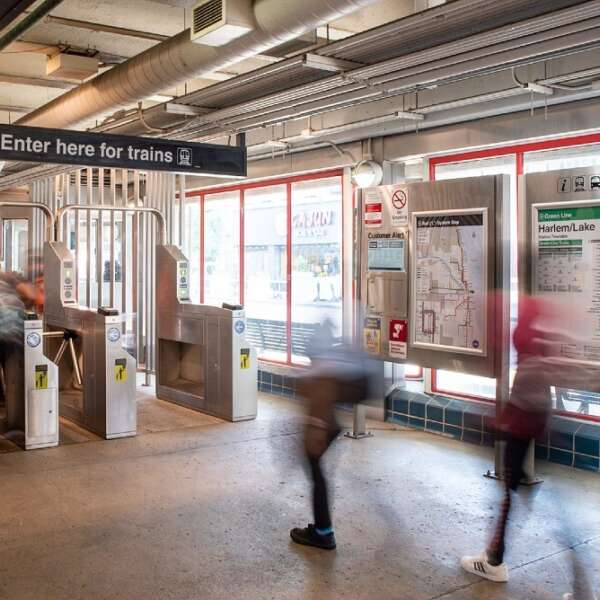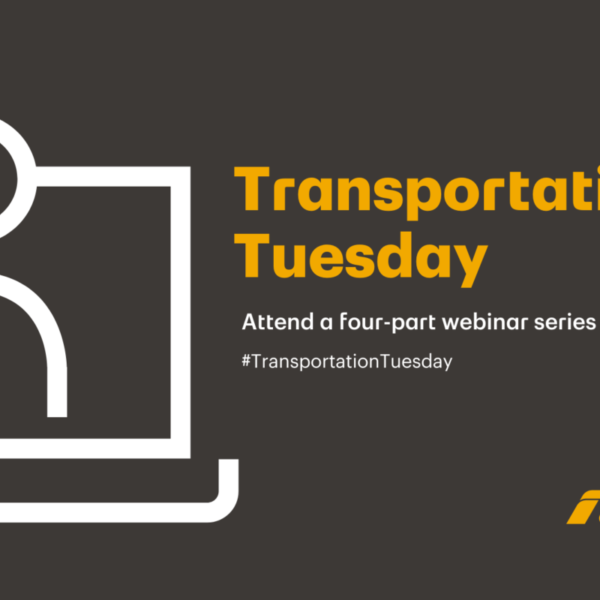What is the ‘fiscal cliff’ and what can be done about it?
December 15, 2022
December 15, 2022

After more than a year of engagement, the RTA has released a draft regional transit strategic plan, Transit is the Answer, which the RTA Board of Directors will consider for adoption during their February 16 meeting. The plan illustrates how transit is the answer to some of the most urgent challenges facing our region. Chicagoland’s public transit system contributes to our region’s economic, social, and environmental health in ways and at a scale nothing else can.
Stakeholders and the public have been clear that transit is a valuable asset that needs to be preserved, improved, and expanded. However, the reality of transit systems nationwide is that they have been undervalued and underinvested as public funds have been channeled to roads, parking, and other infrastructure that supports autos more than transit. The transit system now faces the additional instability of a looming operating funding crisis as federal COVID-19 relief dollars are set to run out near the end of 2025. Investment must continue at even greater levels far into the future in order to make transit more modern, competitive, and reliable.
The Chicago region’s transit system is currently funded by a combination of regional sales tax, funding from the state of Illinois, and revenue generated by the system like fares paid by riders. Chicago’s transit systems continued to be a lifeline for hundreds of thousands of daily riders during the worst of the pandemic. While many continued to ride, many other people stopped riding transit or rode less frequently, which meant that fewer fares were collected, and the RTA system — like many transit agencies across the county — faced an immediate budget crisis.
The federal government, over two administrations of differing political parties, responded and recognized the need for and importance of continued transit operations relief funding in 2020 and 2021. In total, RTA received an allocation of $3.5 billion in federal relief funding to help offset fare revenue losses from declining ridership due to the pandemic. This relief funding combined with RTA sales tax and state funding buoyed the transit system through the darkest early months of the pandemic and continues to support it today. However, we estimate we will hit our fiscal cliff near the end of the 2025, when this federal relief funding is expected to run out.
Despite current and future plans to make immediate and more long-term changes to bring back riders, overall ridership isn’t expected to recover to 2019 levels for the foreseeable future. While significant ridership recovery has occurred, the impacts of the pandemic and permanent changes in remote and hybrid work are projected to result in lower levels of ridership for the remainder of the decade compared to 2019.
Beginning in 2026, the system could face a $730 million annual budget gap assuming current service levels are maintained regionwide. At nearly 20% of the annual expense budget, this gap, if unaddressed, would drastically impact current service and prohibit any additional improvements to the regional system.
This budget gap is not unique to the RTA region, and in fact, our transit system has more time to address the shortfall than many major systems across the country, according to an analysis by TransitCenter as reported by Governing Magazine. For example, Washington, D.C.’s Washington Metropolitan Area Transit Authority faces a funding gap of $519.3 million in the fiscal year 2024 budget. Boston’s Massachusetts Bay Transportation Authority faces a funding gap of $236 million in fiscal year 2024. Philadelphia’s Southeastern Pennsylvania Transportation Authority faces a funding gap of $269 million in 2026. According to The New York Times, New York City’s Metropolitan Transportation Authority is exploring raising fares twice by 2025 to fill a nearly $3 billion budget gap in 2025.
Every major transit agency across the country has been held up by federal COVID-19 relief funding, and all are working to find solutions to fill their budget gaps before they hit their own fiscal cliffs.
If no action is taken, the CTA, Metra, and Pace will be faced with difficult choices to cut service, raise fares, or both. Actions to dramatically cut operating costs could include instituting major lay-offs, route or line eliminations, service cuts, station closures, cancellation of capital improvement projects, and other drastic measures that will further damage our transit system and cause massive disruptions to the region’s economy, workforce, and communities.
Even that won’t be enough. It is impossible for RTA and the Service Boards to solve the funding crisis by raising fares alone, as fare increases of the magnitude needed to fill the budget gap—nearly doubling from what they are today—would drive down ridership and negate additional revenue brought in by higher fares. Even if ridership were assumed to be unaffected by fare increases (an assumption which is not supported by empirical evidence from studies on rider behavior), such large fare increases would be truly unprecedented and render the system unaffordable for many riders, particularly the most vulnerable users who have few other options.
Drastic fare increases would also cause people to find other travel options and drive down ridership even further, necessitating more fare increases or additional reductions in service, further decreasing ridership and eroding transit across the region to a point where the system would no longer be recognizable to an area resident today. Doubling of fares is simply unrealistic, as it would make the system one of the most expensive in the country, make transit less competitive with other modes, and cause dire consequences.
During the RTA’s strategic plan process, we asked people how the region should respond to a potential future budget deficit—by scaling back service or pursuing additional funding for transit. Survey respondents overwhelmingly indicated that RTA should pursue additional funding to maintain our robust transit system (87%) rather than cutting service (13%). These same sentiments were echoed in the hundreds of conversations we had with residents across the region and the dozens of stakeholder workshops we organized. These conversations and in-depth discussions underscored the fact that people want to maintain the system and see increased investment to make transit safer, more reliable, and accessible to everyone.
Knowing that a future funding crisis is looming, RTA and the Service Boards are working hard to avert these financial challenges and evolve toward a more sustainable funding structure. A Technical Working Group composed of staff from the RTA, Service Boards, and Chicago Metropolitan Agency for Planning (CMAP) was dedicated to this subject during the plan development process. The group identified and evaluated 27 federal, state, and local revenue policies to support the Chicago regional transit system. Each revenue policy was evaluated and scored based on several criteria, including annual revenue estimates, impacts of the funding source on historically disadvantaged groups, and the resources needed to establish the revenue source and collect revenue. The 11 highest-scoring funding solutions and estimated potential yields are highlighted in Transit is the Answer.
The findings of the analysis demonstrate that no single funding proposal would be able to generate sufficient revenue to avert the projected fiscal cliff of $730 million in 2026 for the existing transit system, let alone fund major improvements or expansions to the system that the public wants to see. The region will need to explore options in these areas and/or pursue several additional state and local funding mechanisms. To close the financial gap and support future improvements, the region may also need to pursue dedicated federal assistance for transit operations.
Our region is faced with a choice. We can choose to come together and find new, sustainable ways to fund transit and invest in our region’s future. Or we could face an alternate future where we fail to act—isolating many of our most vulnerable residents, jeopardizing our economy, putting our environment in peril, and worsening the inequities across our region.
The RTA along with the CTA, Metra, and Pace, and hundreds of stakeholders and partners, who worked together to develop Transit is the Answer, believe the goals and actions described in the plan can move us closer to a transit system that provides all residents of our region, from the most vulnerable to the most privileged, with safe, swift, and secure passage.
Critical to achieving this vision will be taking this opportunity—this moment—to forge a fundamental change in how we fund transit that is less reliant on fares and recognizes the extraordinary value—the inherent public good—that a well-funded and well managed transit system brings.
The RTA is committed to change, to acting where we can, to advocating tirelessly where we cannot act, and to holding ourselves and our partners accountable. We ask those who share our vision and passion to join us, to provide your wisdom and feedback, and to work with us in achieving the public transit system we know is possible.
Transit is the answer to many of the most urgent challenges facing us today, and investing in transit is key to advancing equity, growing our economy, and combating climate change. We anticipate federal COVID-19 relief funding to last through 2025. After that, our transit system faces a $730 million annual budget gap that cannot be closed by raising fares or cutting service—increased public funding is essential.
Transit is the Answer identifies potential funding solutions and lays out an agenda for advocacy and action that addresses safety, reliability, speed, and other improvements to the system. It is our shared responsibility to build a sustainable model of investment in the operations, upkeep, and modernization of our regional public transportation assets. Join our coalition to take future action and advocate with us for these solutions.
Subscribe to our Newsletter
Related Articles
 Why fully funding paratransit service and reduced fare programs is key to closing the transit budget gap
Why fully funding paratransit service and reduced fare programs is key to closing the transit budget gap
With transit facing a fiscal cliff in 2026, fully funding critical programs like ADA paratransit service and free and reduced fare programs is one key to clo...
February 18, 2025 New stations on CTA Green Line, Metra UP-N line increase transit access for residents, riders
New stations on CTA Green Line, Metra UP-N line increase transit access for residents, riders
In 2024, CTA and Metra opened two new stations: the Damen station in Chicago’s Near West Side neighborhood along CTA’s Green Line and the Peterson/Ridge stat...
January 28, 2025 2025 Regional transit budget available for public comment, foreshadows risk to system’s future without fiscal cliff solution
2025 Regional transit budget available for public comment, foreshadows risk to system’s future without fiscal cliff solution
The RTA has released the 2025 Regional Transit Operating Budget and Five-Year Capital Program for download and public comment. The budget comes as an operati...
November 15, 2024 With equity at the forefront, CTA, Metra, and Pace open new facilities, prioritize upgrades in south and west communities
With equity at the forefront, CTA, Metra, and Pace open new facilities, prioritize upgrades in south and west communities
This year, CTA and Pace have opened or advanced various new facilities in south and west communities throughout the region, and Metra has prioritized upgrade...
October 9, 2024 New project management oversight report highlights more than 100 projects representing $8.2 billion in capital investments
New project management oversight report highlights more than 100 projects representing $8.2 billion in capital investments
The RTA’s Project Management Oversight (PMO) program ensures that the Service Boards—CTA, Metra, and Pace—are spending capital funds and managing their infra...
June 27, 2024 Transportation Tuesday recap: Improving and expanding the transit system strategically
Transportation Tuesday recap: Improving and expanding the transit system strategically
With last year’s adoption of Transit is the Answer came 15 new evaluation metrics that comprise a strategy for evaluating and selecting capital projects. Now...
May 30, 2024